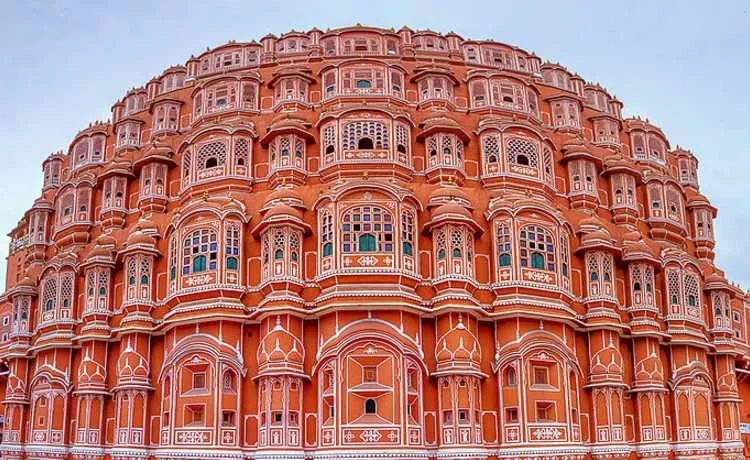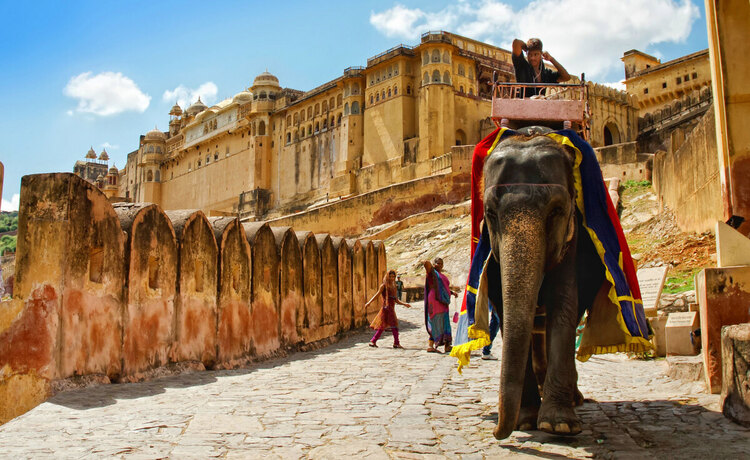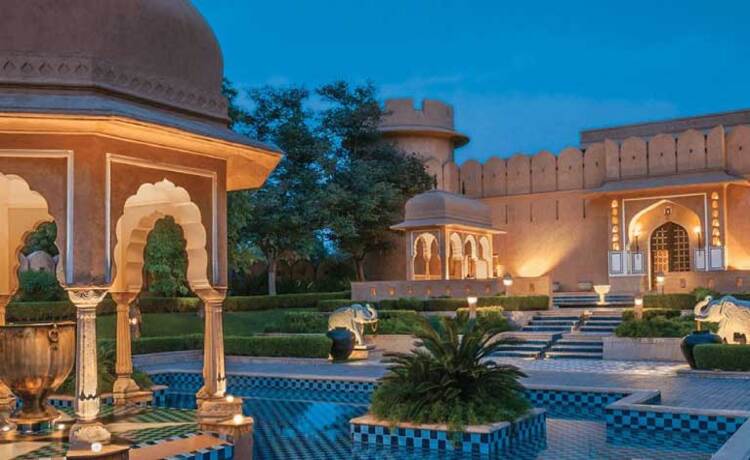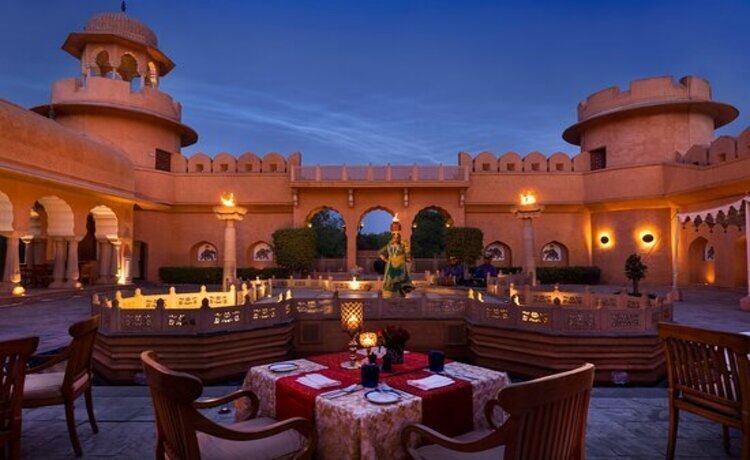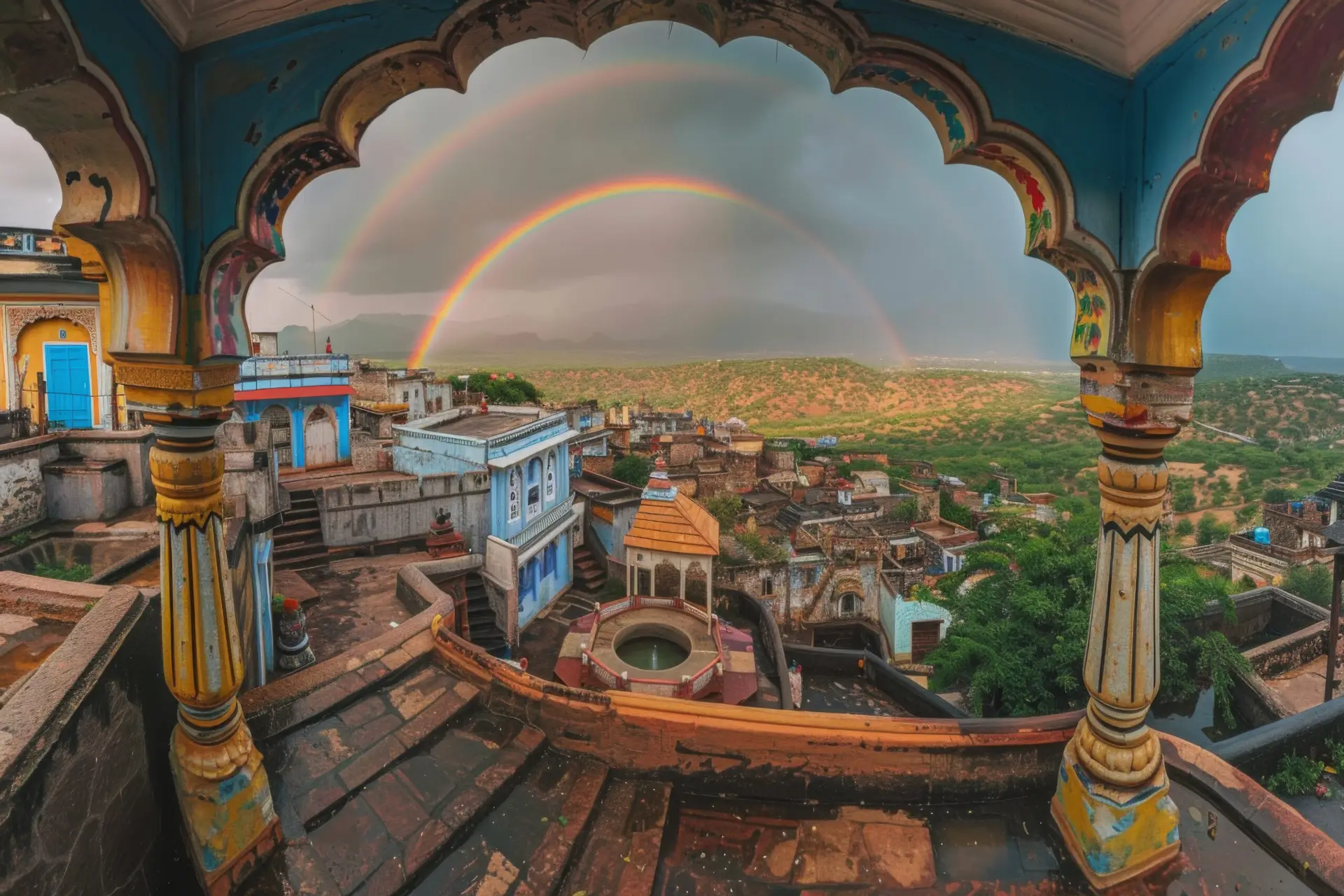Hawa Mahal Jaipur Travel Guide 2025: Entry Fee, Timings, History & Top Tips
About Hawa Mahal
Hawa Mahal, the iconic “Palace of Winds” in Jaipur, stands as a testament to Rajasthan’s rich cultural heritage and architectural brilliance. Known for its stunning façade with over 900 intricately designed windows, this historical gem draws millions of visitors each year. Whether you’re captivated by its beauty, fascinated by its history, or simply looking for a great spot to snap some unforgettable photos, this complete guide will help you plan your perfect visit. In this guide, you’ll find everything you need to know about Hawa Mahal in 2025, including entry fees, opening hours, the best time to visit, fascinating historical facts, and expert travel tips to make your experience unforgettable. Let’s get ready to explore one of Jaipur’s most celebrated landmarks!
Hawa Mahal, also called the “Palace of Winds,” is a famous building in Jaipur, Rajasthan, India. It was built in 1799 by Maharaja Sawai Pratap Singh. This beautiful palace is known for its pink stone walls and lots of small windows, called “jharokhas,” that look like a beehive.
The windows were made so the royal women could see the busy streets and festivals below without being seen by others.The palace has five floors, and its special shape looks like the crown of Lord Krishna. Hawa Mahal was a place for the royal women to relax while staying private and safe. It was also built to show the Maharaja’s love for art and to protect the culture of Rajasthan.
Today, Hawa Mahal is one of Jaipur’s most popular places. People from all over the world come to see its amazing design, rich history, and beautiful views of the city. It is a proud symbol of Rajasthan’s history and culture.
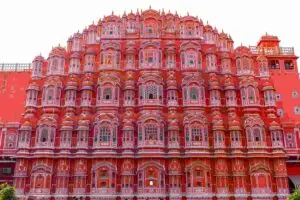
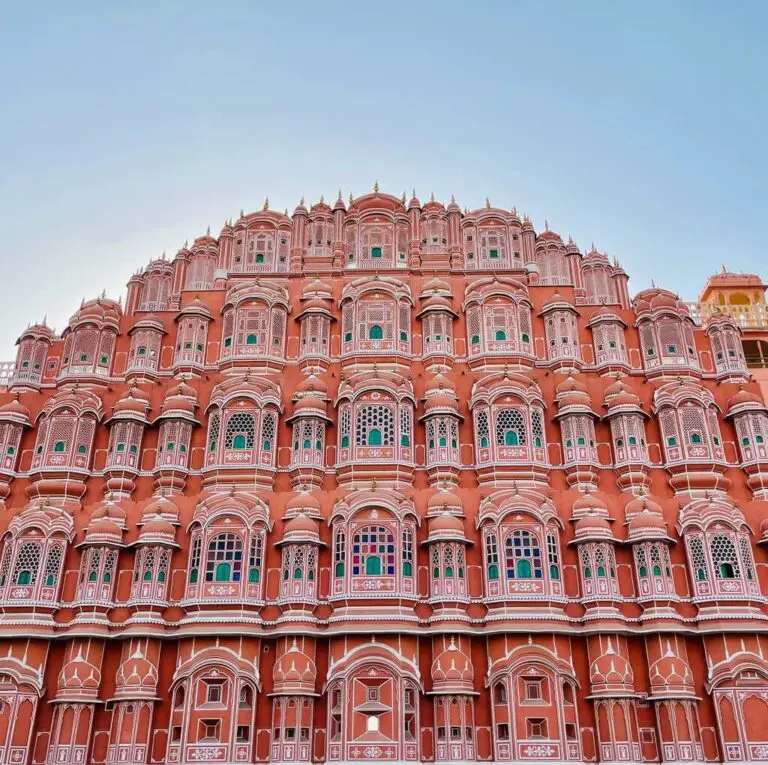
Jaipur Tour Packages
HISTORY UNVEILED
History is like a big story that people have been telling for thousands of years. Archaeologists, historians, and smart thinkers have worked hard to uncover bits and pieces of the past. These discoveries help us understand the world from long ago, with stories of success, failure, and change. Every time something new is found, it adds to what we know about old cultures, forgotten cities, and hidden histories.
As we learn more, we see how people lived, what they built, and how they faced their challenges. These stories help us see how humans are all connected across time and space. They show how empires grew and fell, and how people showed their strength and creativity.
History is not just something from the past. It is also a guide for today and tomorrow. By studying it, we can understand where we come from and how to make better choices in the future. History is alive, teaching us lessons from what worked and what didn’t. By looking back, we can move forward and keep learning.
HAWA MAHAL: JAIPUR'S JEWEL OF ARCHITECTURE
Attribute | Details |
Location | Jaipur, Rajasthan, India |
Built | 1799 |
Built by | Maharaja Sawai Pratap Singh |
Architectural Style | Rajputana with Mughal influences |
Materials | Red and pink sandstone |
Height | 50 feet (15 meters) |
Structure | Pyramid-shaped, five-story building |
Number of Windows | 953 |
Purpose | Originally built as an extension of the City Palace, to allow royal women to observe street festivals and daily life without being seen |
Significance | Cultural landmark, symbol of Jaipur's heritage |
Accessibility | Open to tourists for visits and photography |
Nearby Attractions | City Palace, Jantar Mantar, Nahargarh Fort |
Architectural Marvels of Hawa Mahal
Hawa Mahal, also known as the “Palace of Winds,” is a beautiful building in Jaipur, Rajasthan, India. It was built in 1799 by Maharaja Sawai Pratap Singh. The palace has five floors and shows the rich and creative style of the Rajput kings.
One of the most special parts of Hawa Mahal is its front wall, which looks like a honeycomb with 953 small windows, or “Jharokhas.” These windows are carefully carved into the pink stone. The windows have delicate designs and serve two main purposes. They let the royal women, who were not allowed to be seen in public, watch the busy life and celebrations in the streets below. The windows also helped cool the palace by letting the wind pass through, which is why it is called the “Palace of Winds.”
The design of the palace mixes Rajput and Mughal styles. The front wall has many details and decorations in the Rajput style, while the overall shape and structure are inspired by Mughal buildings. The palace is shaped like Lord Krishna’s crown, which is a symbol of divinity and power. The pyramid shape and the pink stone make it look even more grand.
Today, Hawa Mahal is a famous symbol of Jaipur’s history and culture. It shows the skill of the artists who built it with their beautiful patterns and designs. Visitors come from all over the world to admire its timeless beauty.
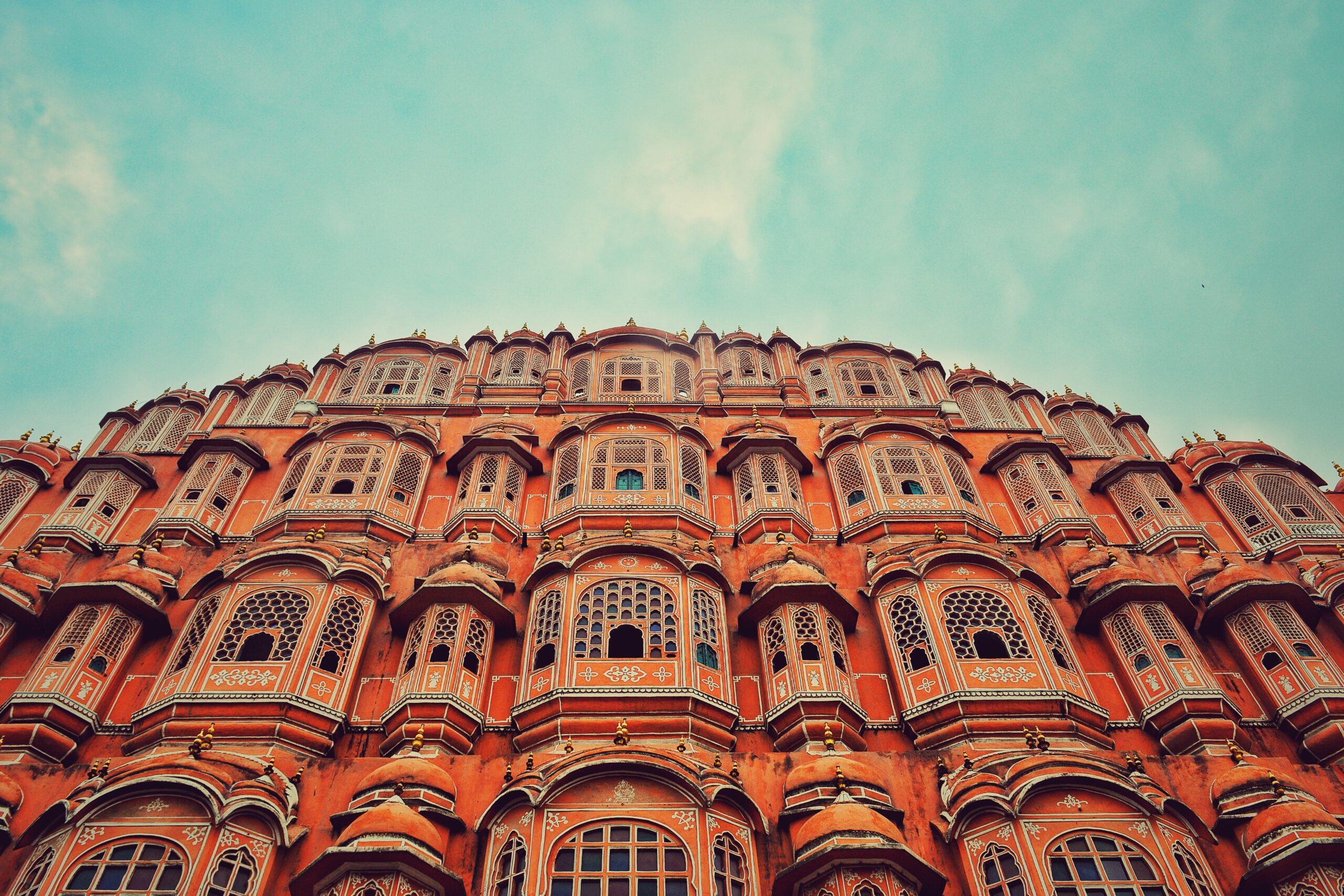
Why Choose Us?
- Expertise: We offer years of experience in organizing seamless visits to Hawa Mahal, ensuring a smooth and enriching experience.
- Local Knowledge: Our guides are well-versed in Jaipur’s history, culture, and architecture, offering unique insights into the charm of Hawa Mahal.
- Personalized visits: We offer customized ticketing and itinerary options to ensure that you can explore the charm of Hawa Mahal at your pace.
- Safety First: We prioritize visitor safety with clear guidelines, trusted local services, and assistance during your tour.
- Eco-Friendly Options: We encourage sustainable tourism, helping you enjoy Hawa Mahal responsibly while supporting Jaipur’s local communities.
- Affordable Pricing: Our ticket packages are competitively priced, offering exceptional value for money without compromising on quality
- Skip-the-Line Convenience: Enjoy hassle-free entry with our pre-booked ticket services, saving you time and effort
- Cultural Immersion: Enhance your visit with recommendations on nearby attractions, traditional markets, and authentic local cuisine
- Delicious Cuisine: Enjoy hearty meals prepared by our skilled cooks, featuring local flavors and ingredients.
- Memorable Experiences: Capture lifetime photograph by allowing the sight of Hawa Mahal give you the grandeur beauty and the craftsmanship required to construct it.
Explore Jaipur for Travel
Hawa Mahal Highlights
Hawa Mahal, also known as the Palace of Winds, is a stunning architectural wonder located in Jaipur, India. Here are some highlights of this iconic structure:

Distinctive Design
Hawa Mahal has a very special design. The building looks like a honeycomb, which is full of small windows. There are 953 windows in total! The shape of the windows makes cool air come into the palace, so it’s always nice and fresh inside. This is why it’s called the Palace of Winds. The outside of the building is made from red and pink sandstone, and the design is very detailed and pretty, with lots of small carvings.History
This palace was built in 1799 by Maharaja Sawai Pratap Singh, the ruler of Jaipur. The building was meant for the women of the royal family. In old times, women in the royal family couldn’t be seen by the public, so the palace allowed them to look at the streets and festivals without anyone seeing them. This way, they could enjoy the life outside while still being private.Great Location
Hawa Mahal is right in the middle of Jaipur’s busy old city. It overlooks a main street, so people in the palace could watch everything happening in the city. This way, the royal women could see the events and life on the streets, from a safe distance.Beautiful Architecture
The building has five floors, and it is shaped like a pyramid. The walls have many balconies with carved designs, and there are domed roofs on top. The building has a mix of Rajputana and Mughal architectural styles, showing the rich history and culture of the region. The whole building looks beautiful and is designed to be very grand and special.Perfect for Photography
Because of its amazing design and the way light hits the building during sunrise and sunset, Hawa Mahal is one of the best places to take photos. Photographers love taking pictures of the palace because it looks so stunning. The sunlight shines on the red sandstone and creates beautiful colors and shadows that make the building look even more beautiful.Cultural Importance
Hawa Mahal is not just a pretty building. It is an important symbol of Jaipur’s history and culture. The palace has been featured in many films, documentaries, and books. This makes it a well-known place, not just in India but around the world. It tells the story of how royalty lived in the past and is a proud part of Jaipur’s past.Fun Facts
The building has a lot of small windows, which is why it looks like a honeycomb.
The design is inspired by the crown of Lord Krishna.
It was built as an extension of the City Palace in Jaipur.
Hawa Mahal is a very famous and beautiful palace that tourists from all over the world come to see. Its stunning design, rich history, and cultural importance make it one of the most iconic landmarks in Jaipur.
Hawa Mahal Tickets
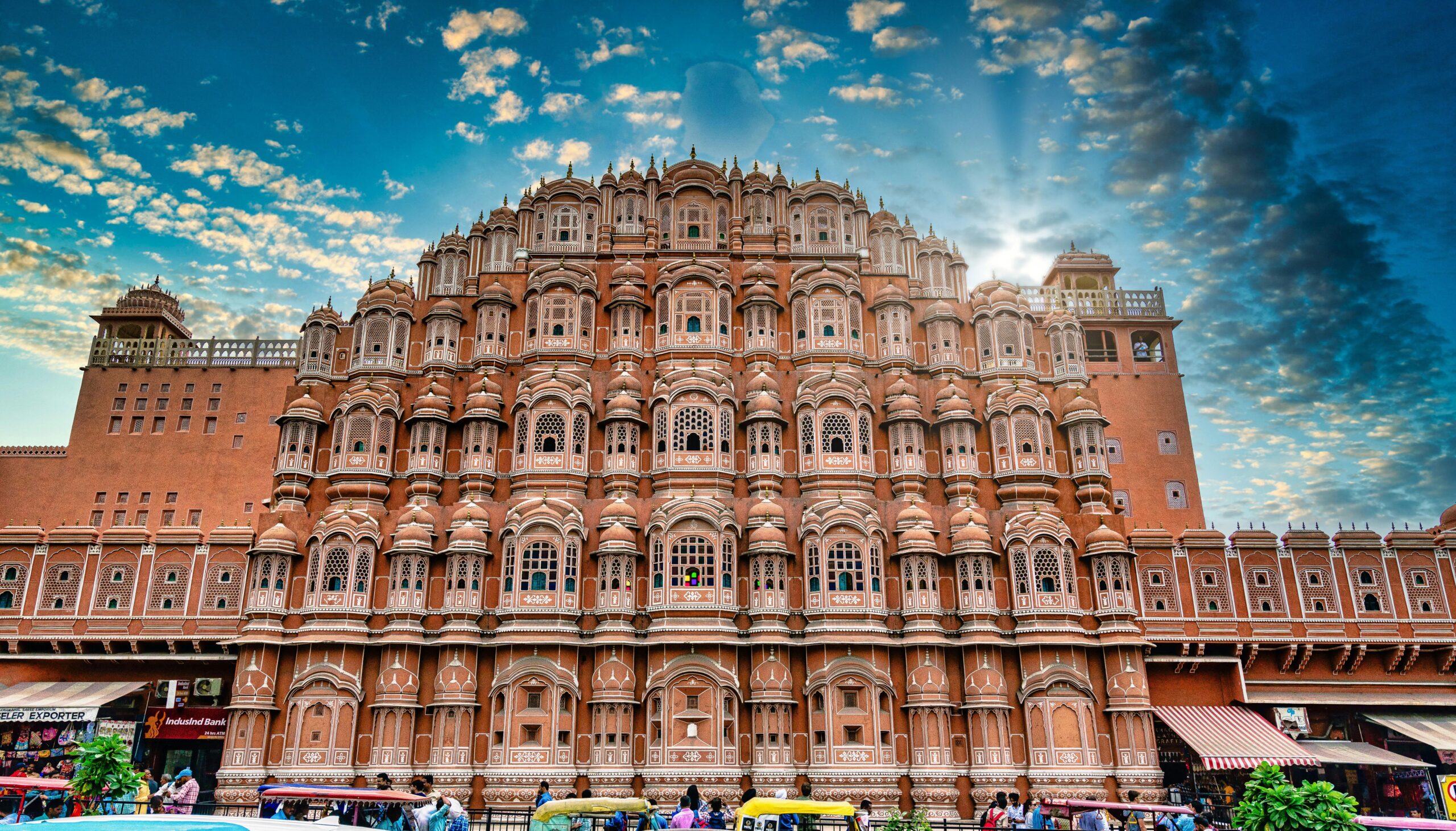
Ticket Prices:
- Indian Visitors: ₹50
- Foreign Visitors: ₹200
- Indian Students: ₹20 (discounted price)
Where to Buy Tickets:
- You can buy tickets at the entrance of Hawa Mahal.
- Online booking option is available on our site.
Opening Hours:
- Hawa Mahal is open every day from 9:00 AM to 4:30 PM.
Extra Charges:
- There may be extra charges if you want to take photos or videos.
- The charges change, so check the rules when you visit.
About the Attraction:
- Hawa Mahal was built in 1799 by Maharaja Sawai Pratap Singh.
- It has a special design that lets cool air flow through the building, which helps in the hot weather of the desert.
Nearby Places to Visit:
- Hawa Mahal is close to the City Palace and Jantar Mantar, so you can visit these places too.
Best Time to Visit:
- The best time to visit is early in the morning or late in the afternoon when it is not crowded.
Hawa Mahal Tickets and Information
You can buy Hawa Mahal tickets at the gate or online.
Ticket Prices:
Indian Visitors: ₹50
Foreign Visitors: ₹200
Indian Students: ₹20 (special discount)
Where to Buy Tickets:
At the Entrance: You can buy tickets when you reach Hawa Mahal.
Online: You can also buy tickets from websites on the internet.
Composite Tourist Ticket: You can buy one special ticket that lets you visit Hawa Mahal and other places too.
Opening Hours:
Hawa Mahal is open every day from 9:00 AM to 4:30 PM.
Extra Information:
You might need to pay extra money if you want to take photos or videos. It’s a good idea to ask about this when you get there.
Hawa Mahal is very famous, so it gets crowded. If you go early in the morning or later in the afternoon, you can enjoy better without too many people.
Interesting Facts about Hawa Mahal
- The world’s tallest building without foundation: But the five storey building, hawa Mahal, is standing without any firm foundation. It’s stable due to its pyramid like shape.
- Airy building: Thus, good air all time flows here and therefore it feels good even in the summer.
- Specially built for royal women: In this palace, queens and royal women were built in which they can see the outside view without being seen in the public place.
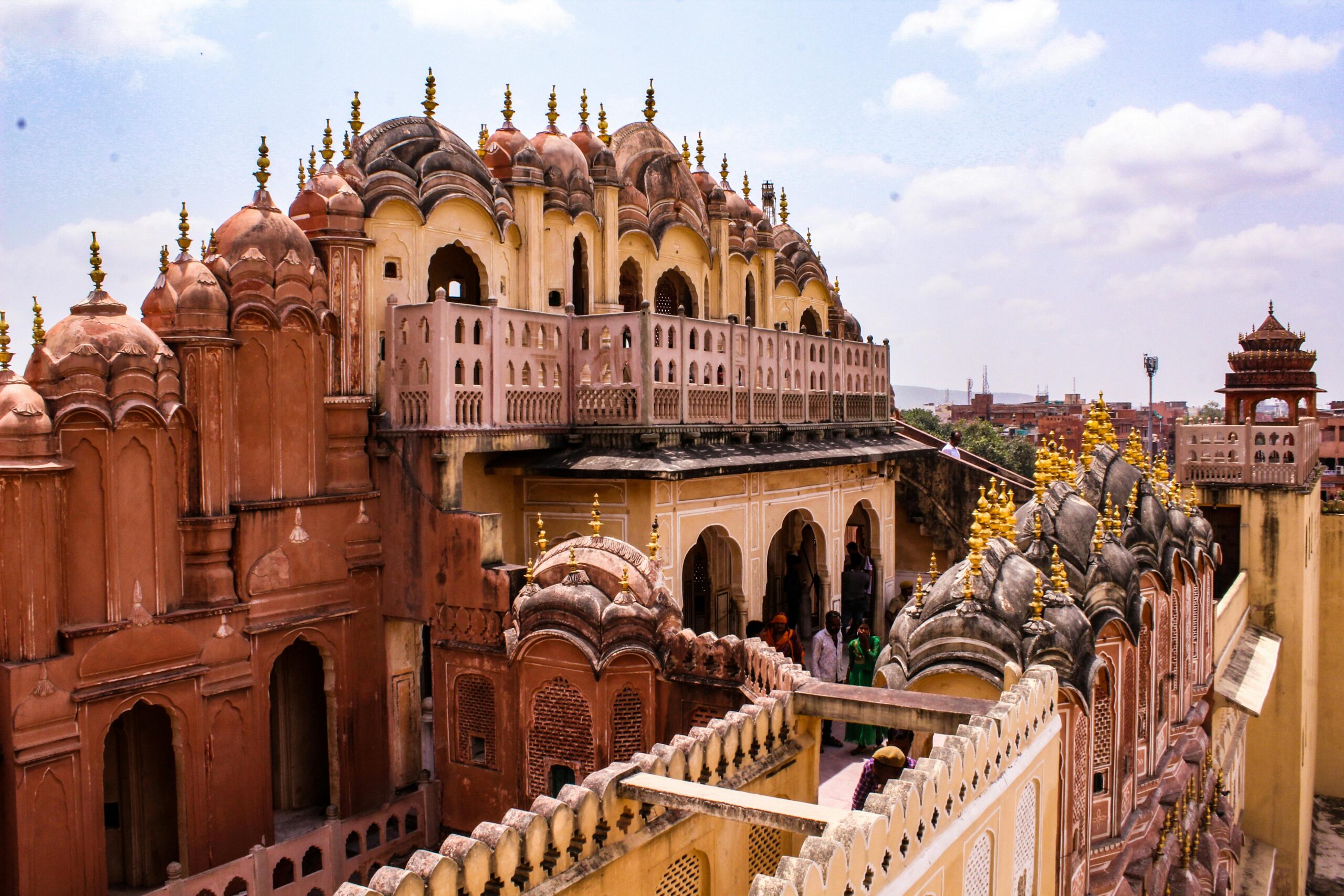
How to Plan Visit Hawa Mahal
📍 Location and How to Reach
Hawa Mahal is conveniently located near Badi Chaupar in Jaipur’s old city area. It’s accessible by local buses, autorickshaws, and private cabs. Jaipur International Airport is approximately 13 km away, while Jaipur Junction Railway Station is 5 km away.
🕒 Best Time to Visit
Plan your visit between October and March for pleasant weather. Early mornings are ideal for breathtaking views and photography. The palace opens from 9:00 AM to 5:00 PM every day.
💵 Ticket Prices
- Indian tourists: ₹50
- Foreign tourists: ₹200
Tickets are available at the entrance and online via the Rajasthan Tourism website.
🏰 What to Explore
Explore the beautiful architecture, including the pink sandstone façade, the intricate latticework, and the panoramic city views from the top floor. Don’t miss the small museum showcasing royal artifacts and historical exhibits.
📸 Photography Tips
Capture the palace from outside during sunrise for golden hues. Inside, the top-floor views and lattice windows make for Instagram-worthy shots.
🛍️ Nearby Attractions
- Johari Bazaar: Perfect for jewelry shopping.
- Jantar Mantar: UNESCO World Heritage Site.
- City Palace: A blend of Mughal and Rajasthani styles.
✅ Tips for Visitors
- Wear comfortable footwear for walking.
- Carry water and sunscreen during your visit.
- Respect cultural norms while taking photos.
How to Reach Hawa Mahal: A Complete Guide for Travelers
Where is Hawa Mahal Located?
Hawa Mahal is situated at Badi Choupad, Jaipur, Rajasthan, in the heart of the Pink City. It is conveniently located near other popular attractions such as the City Palace and Jantar Mantar, making it a key stop on any Jaipur itinerary.
For easy navigation, you can locate Hawa Mahal on Google Maps.
Transportation Options to Reach Hawa Mahal
1. By Air
The nearest airport to Hawa Mahal is Jaipur International Airport, located approximately 13 km away.
- Travel Time: 30-45 minutes.
- Options:
- Prepaid taxis and ride-hailing services like Uber and Ola.
- Airport shuttles connecting to key points in Jaipur.
2. By Train
Jaipur Junction is the city’s main railway station, just 5 km from Hawa Mahal.
- Travel Time: 15-20 minutes.
- Options:
- Auto-rickshaws or tuk-tuks are affordable options for this short distance.
- Pre-booked cabs for a comfortable ride.
3. By Road
Jaipur is well-connected by road, making Hawa Mahal easily accessible for both local and outstation travelers.
- By Car:
Use NH48 if you’re driving from Delhi, which is roughly 270 km away. Parking facilities are available near Badi Choupad. - By Bus:
Rajasthan State Road Transport Corporation (RSRTC) buses and private operators run services to Jaipur from nearby cities like Delhi, Agra, and Udaipur. From the bus stop, hire an auto-rickshaw or cab to reach Hawa Mahal.
4. Public Transport
Jaipur offers several economical public transport options:
- Tuk-tuks: Ideal for short distances; fares can be negotiated.
- City Buses: Jaipur’s low-floor buses have routes passing close to Hawa Mahal. Ask locals for the nearest stop.
5. Walking
If you’re staying at a hotel in Jaipur’s Old City, you can enjoy a pleasant walk to Hawa Mahal. This allows you to explore the vibrant markets and streets en route.
Best Time to Visit Hawa Mahal
Hawa Mahal is open daily from 9:00 AM to 4:30 PM.
- Morning: The early hours are perfect for avoiding crowds and capturing stunning photos in the morning light.
- Season: Plan your visit between October and March for pleasant weather, as Jaipur experiences intense heat during the summer.
Nearby Attractions to Explore
While visiting Hawa Mahal, you can explore several nearby landmarks:
- City Palace (700 m away): Dive into Jaipur’s royal history.
- Jantar Mantar (500 m away): Admire the UNESCO World Heritage-listed astronomical instruments.
- Johari Bazaar (1 km away): Shop for traditional jewelry and textiles.
Travel Tips for Visiting Hawa Mahal
- Tuk-Tuk Fares: Expect to pay ₹50-₹150 for a tuk-tuk ride within Jaipur.
- Comfortable Shoes: Jaipur’s streets can be busy, so wear sturdy footwear.
- Ticket Info: Entry tickets for Hawa Mahal cost approximately ₹50 for Indians and ₹200 for foreign tourists.
FAQs
1. What is the historical significance of Hawa Mahal?
Hawa Mahal, also known as the “Palace of Winds,” is a historic monument in Jaipur, India. Built in 1799 by Maharaja Sawai Pratap Singh, it was designed to allow royal women to observe street festivities without being seen, adhering to the purdah system. It also symbolizes Jaipur’s rich Rajput heritage.
2. Why was Hawa Mahal built, and what was its purpose?
Hawa Mahal was constructed to provide a private and secure viewing space for the royal women of the Rajput court. Its unique structure, featuring numerous small windows, allowed them to watch street processions and daily market activities while maintaining their privacy.
3. What are the unique architectural features of Hawa Mahal?
Hawa Mahal is a five-story structure made of red and pink sandstone, resembling a honeycomb with 953 small jharokhas (windows). Its pyramid-like facade has intricate latticework, and despite its towering appearance, it lacks a foundation, relying on its curved shape for stability.
4. How does the design of Hawa Mahal help with ventilation and cooling?
The numerous jharokhas create a natural air-conditioning effect. The Venturi effect allows cool air to circulate through the palace, maintaining a pleasant temperature even during the scorching summers of Rajasthan. This passive cooling system is an early example of sustainable architecture.
5. What is the best time of year to visit Hawa Mahal?
The best time to visit Hawa Mahal is during the cooler months from October to March. Early morning visits are ideal, as the sunlight bathes the facade in a golden glow, enhancing its beauty.
6. Are there guided tours available for Hawa Mahal, and what do they include?
Yes, guided tours are available, both in-person and via audio guides. These tours provide insights into the history, architectural significance, and cultural importance of Hawa Mahal. Some tours also include nearby attractions like Jantar Mantar and City Palace.
7. What are some interesting facts about Hawa Mahal that most people don’t know?
- Hawa Mahal was inspired by the crown of Lord Krishna, reflecting the devotion of Maharaja Sawai Pratap Singh.
- Despite its grand exterior, the interior consists of narrow corridors and minimal decorations.
- The palace does not have a front entrance; visitors must enter from the City Palace side.
- It was built without a foundation yet remains standing due to its unique curved structure.
8. How does Hawa Mahal reflect the Rajput and Mughal architectural styles?
Hawa Mahal blends Rajput and Mughal architectural influences. The chhatris (domed pavilions) and floral motifs are characteristic of Rajput design, while the arched windows and intricate latticework show Mughal influences, particularly in terms of aesthetics and ventilation.
9. What are the nearby attractions to visit along with Hawa Mahal?
- City Palace – A magnificent palace complex showcasing Rajput architecture and royal artifacts.
- Jantar Mantar – An astronomical observatory with ancient instruments.
- Johari Bazaar – A vibrant market famous for gemstones, jewelry, and textiles.
- Albert Hall Museum – Rajasthan’s oldest museum, exhibiting historical artifacts.
- Nahargarh Fort – Offers stunning panoramic views of Jaipur.
10. Is there an entry fee for Hawa Mahal, and what are the visiting hours?
Yes, the entry fee is as follows:
- Indian Visitors: ₹50
- Foreign Tourists: ₹200
- Children: ₹25
Visiting Hours: 9:00 AM – 5:00 PM daily. It is advisable to check for any updates before visiting.
11. Where can I buy tickets for Hawa Mahal?
- You can buy tickets for Hawa Mahal at the entrance gate of the monument. Online tickets are also available through official Rajasthan tourism websites and platforms like BookMyShow, MakeMyTrip, and other travel portals.
12. What is the ticket price for visiting Hawa Mahal?
- The ticket prices for Hawa Mahal are as follows:
- Indian tourists: ₹50 per person
- Foreign tourists: ₹200 per person
- Children (Indian & Foreign, below 7 years): Free entry
Prices may be subject to change, so checking the official Rajasthan tourism website is advisable.
13. Are there any discounts available on Hawa Mahal tickets for students or senior citizens?
- Yes, students with valid ID cards may get discounted entry, though this depends on policies at the time of visit. Senior citizen discounts are not always available, but some group tours may offer them. It is best to inquire at the ticket counter.
14. Can I book Hawa Mahal tickets online in advance?
- Yes, tickets can be booked online in advance through official government websites like Rajasthan Tourism, as well as private travel platforms such as BookMyShow and Paytm Travel.
15. What are the opening and closing timings for Hawa Mahal?
- Hawa Mahal is open daily from 9:00 AM to 4:30 PM. It is advisable to visit early in the morning to avoid crowds.
16. Is there a separate queue for foreign tourists at Hawa Mahal?
- No, there is no separate queue for foreign tourists. However, ticket prices differ for Indian and foreign visitors, and purchasing tickets online can help avoid long queues.
17. Are guided tours included in the Hawa Mahal ticket price?
- No, guided tours are not included in the standard ticket price. You can hire a local guide at the entrance or use audio guide services available through tourism apps.
18. Can I visit Hawa Mahal with a composite ticket for Jaipur monuments?
- Yes, Rajasthan Tourism offers a composite ticket that covers multiple monuments, including Hawa Mahal, Amber Fort, Jantar Mantar, and City Palace. Prices:
- Indians: ₹300
- Foreigners: ₹1,000
This ticket is valid for two days and allows entry to all included attractions.
19. Is photography allowed inside Hawa Mahal, and does it require an additional ticket?
- Yes, photography is allowed inside Hawa Mahal. There is no additional fee for using mobile cameras, but professional cameras and video recording equipment may require prior permission and an extra charge.
20. What are the best times to visit Hawa Mahal to avoid crowds?
- The best time to visit Hawa Mahal is early in the morning (9:00 AM – 10:30 AM) before large tourist crowds arrive. Visiting on weekdays is preferable, as weekends and holidays tend to be more crowded.
21. What is Hawa Mahal?
Hawa Mahal, also known as the Palace of Winds, is an iconic pink sandstone palace in Jaipur, Rajasthan. Built in 1799, this five-storey architectural marvel features 953 small windows or jharokhas that allow cool breezes to pass through, making it a summer retreat for royal women observing life outside while maintaining purdah.
22. What is the Entry Fee for Hawa Mahal?
Indian Citizens: ₹50 per person
Foreign Tourists: ₹200 per person
23. What are the Hawa Mahal Timings?
Hawa Mahal is open every day of the week from:
🕘 9:00 AM – 5:00 PM
| Day | Timing |
|---|---|
| Monday | 9:00 am – 5:00 pm |
| Tuesday | 9:00 am – 5:00 pm |
| Wednesday | 9:00 am – 5:00 pm |
| Thursday | 9:00 am – 5:00 pm |
| Friday | 9:00 am – 5:00 pm |
| Saturday | 9:00 am – 5:00 pm |
| Sunday | 9:00 am – 5:00 pm |
24. Who Built Hawa Mahal and When?
Hawa Mahal was built in 1799 by Maharaja Sawai Pratap Singh, the grandson of Maharaja Sawai Jai Singh. The palace was designed by Lal Chand Ustad as an extension to the City Palace to allow royal women to observe street festivals discreetly.
25. What is the Historical Significance of Hawa Mahal?
Hawa Mahal stands as a symbol of Rajputana architecture and tradition. It was constructed for royal women to observe public events without being seen due to the Rajput Purdah system. The honeycombed windows facilitate air circulation, making it an ingenious piece of climate-responsive architecture.
26. What is the Contact Number of Hawa Mahal?
You can contact the site management at:
📱 Phone: 0141 261 8862
🌟 Hawa Mahal Ratings
Rating: ⭐ 4/5
Based on: 16 reviews
27. What is the Address/Location of Hawa Mahal?
Hawa Mahal Address:
Hawa Mahal Rd, Badi Choupad, J.D.A. Market, Pink City, Jaipur, Rajasthan 302002, India
📍 View on Google Maps
28. Are There Any Images of Hawa Mahal?
Yes! Hawa Mahal is one of the most photographed landmarks in Jaipur. Some popular images include:
hawa-mahal-jaipur-tourism-entry-fee.jpg
hawa-mahal-jaipur-tourism-history.jpg
hawa-mahal-jaipur-tourism-location-address.jpg
hawa-mahal-jaipur-tourism-opening-time-closing.jpg
(📸 Images Courtesy: shashidhars)
29. What is Unique About Hawa Mahal’s Architecture?
Built with red and pink sandstone
953 small windows (jharokhas) to let the wind pass through
Crown-shaped façade resembling Lord Krishna’s tiara
Five-storey pyramidal structure without stairs — only ramps
A mix of Rajput and Islamic architecture
Features fountains and a natural cooling system (Venturi effect)
30. Does Hawa Mahal Have a Museum?
Yes, it houses an archaeological museum with royal artefacts. The second floor called Ratan Mahal is known for its stained-glass windows that reflect beautiful colours.
31. What Are the Places to Visit Near Hawa Mahal?
Govind Devji Temple (700m)
Chandra Mahal (200m)
City Palace Jaipur (800m)
Jantar Mantar (UNESCO Site) (700m)
32. Where Can I Shop Around Hawa Mahal?
Explore vibrant local markets:
Johari Bazaar – Jewelry and antiques
Bapu Bazaar – Mojaris and traditional wear
Tripolia Bazaar – Lac bangles and textiles
33. What to Eat Near Hawa Mahal?
Dal Kachori from Jain Patang Udyog or Sharma Sweets
Mawa Kachori – Specialty sweet in Jaipur
Omelettes from Sanjay Omelette (Bapu Nagar)
Kulfi Faluda & Golgappas at Bapu Bazaar
34. Can I Book Jaipur Tour Packages Online?
Yes! You can book Jaipur City Tour Packages or Hawa Mahal-specific tours online, which often include nearby attractions, local cuisine tastings, and guided heritage walks.
Would you like additional details or travel tips?
Conclusion
Hawa Mahal is more than just a historical landmark—it is a symbol of Jaipur’s rich heritage and an engineering marvel that showcases the brilliance of Rajput architecture. Its imposing facade, scientific ventilation system, and cultural importance make it an unmissable attraction for history buffs, architecture enthusiasts, and travelers alike. Whether you visit for its aesthetic grandeur, cooling mechanisms, or historical significance, Hawa Mahal stands as a testament to India’s glorious past.
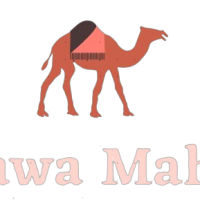
Discover the charm of Jaipur with our seamless travel services, tailored for unforgettable journeys in the Pink City
Services
Quick Links
Get In Touch
Jaipur,Rajasthan
- Email: Travelwithrajeshjat@gmail.com
- Phone: 9664018719
- Hours: Mon-Sat 9:00AM - 5:00PM
© 2025 All Rights Reserved.

